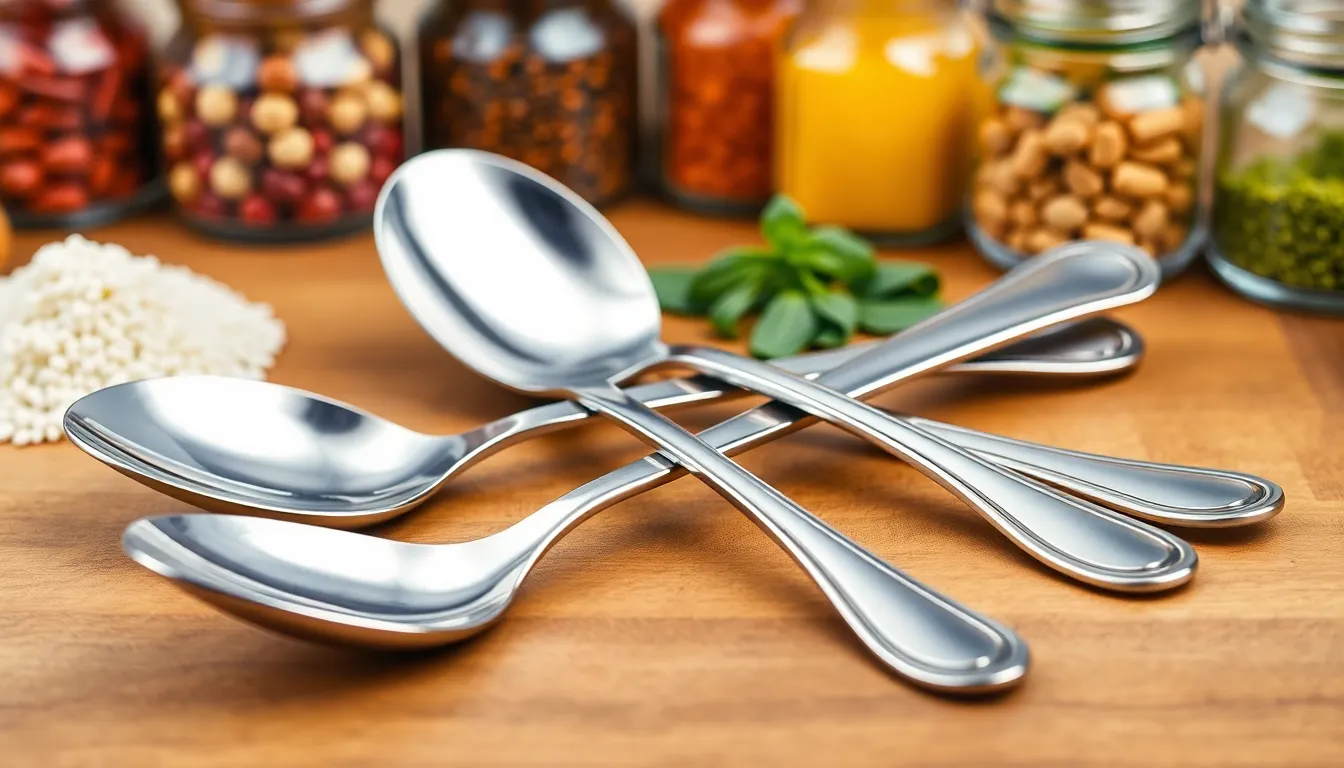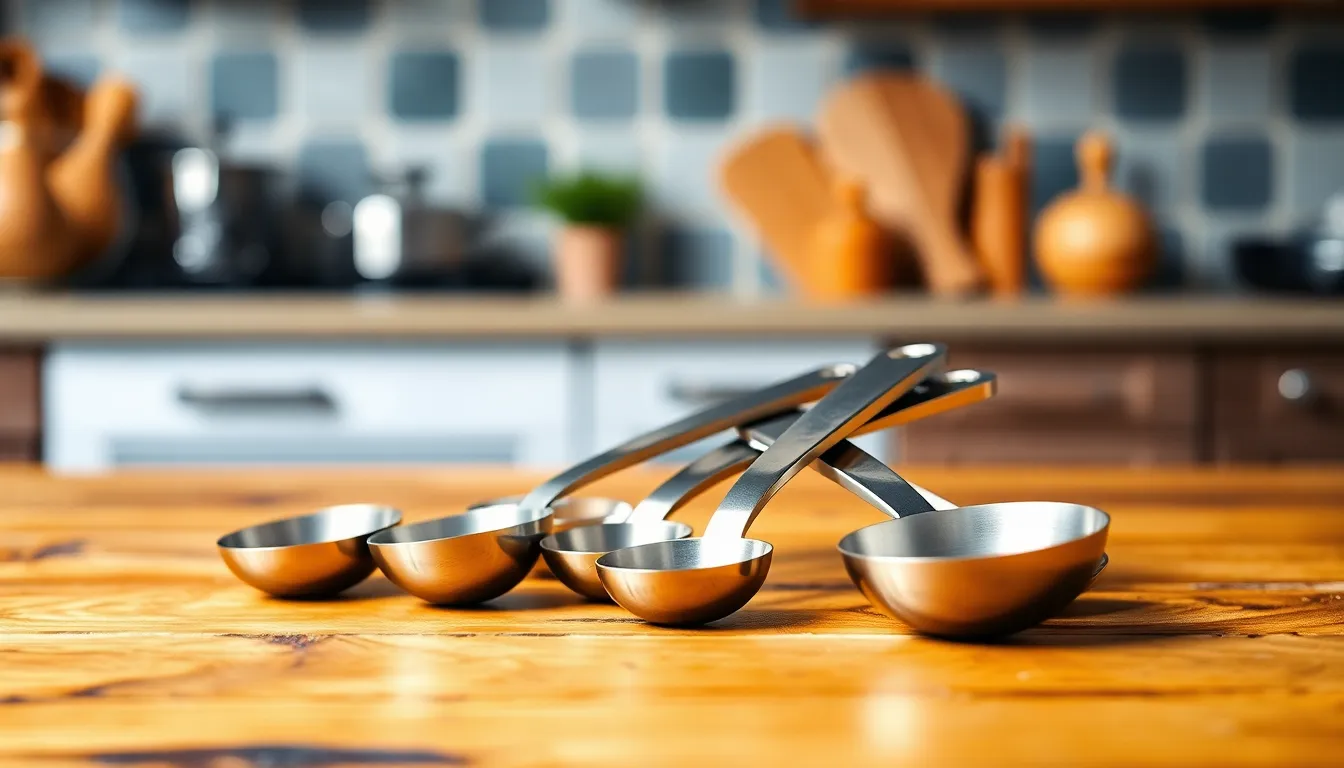Table of Contents
ToggleCooking can feel like a science experiment, and sometimes the measurements can leave even the most seasoned chefs scratching their heads. Ever found yourself staring at a recipe, wondering how many teaspoons fit into a tablespoon? Spoiler alert: it’s not a magic trick, but it can feel like one when you’re in the middle of whipping up a culinary masterpiece.
Understanding Cooking Measurements
Cooking measurements vary across different units, but understanding them simplifies the cooking process. A tablespoon equals three teaspoons, a fact that often confuses cooks. This equivalency plays a crucial role when recipes require accurate measurements for flavor consistency.
Measuring spoons typically come in sets, showing various sizes. It’s essential to choose the right one to ensure proper ingredient proportions. Using the wrong measurement can lead to imbalanced dishes, altering the intended taste.
When converting units, remember that 1 tablespoon translates to 15 milliliters. This conversion assists in adapting recipes from diverse sources. Understanding both metric and customary systems enhances cooking versatility.
Different recipes may specify unique measurement preferences. Some may outline ingredients in teaspoons or tablespoons, while others use cups and pints. It’s beneficial to familiarize oneself with both types for a seamless cooking experience.
Adjusting recipes for dietary needs often involves conversions. If one needs to reduce a recipe, knowing that two tablespoons equal six teaspoons streamlines this process. This adjustment permits more accurate ingredient adjustments without compromising flavor.
Various cooking scenarios necessitate precise measurements. Baking, for example, emphasizes accuracy due to chemical reactions between ingredients. Grams and ounces fill the void in scenarios where precise weights are necessary.
Understanding cooking measurements empowers cooks to navigate recipes confidently and create delicious meals. With practice, converting measurements will become second nature in the kitchen.
The Basics Of Teaspoons And Tablespoons

Understanding teaspoons and tablespoons is essential in cooking. These units help ensure recipes turn out as intended.
Conversion Ratios
A tablespoon equals three teaspoons. This ratio simplifies conversions, allowing for quick adjustments in measurements. For example, knowing that two tablespoons equal six teaspoons aids in recipe modification. When adapting recipes, this conversion provides clarity and accuracy. In metric terms, 1 tablespoon holds approximately 15 milliliters. Familiarity with both measurement systems can improve cooking proficiency significantly.
Common Uses In Recipes
Teaspoons often appear in spice and flavoring measurements. Many recipes specify teaspoons for items like salt, pepper, or herbs. Tablespoons commonly measure larger quantities, such as oils or vinegars. Adjusting serving sizes sometimes requires conversions between the two measurements. Recognizing when to swap between teaspoons and tablespoons can enhance recipe precision. This knowledge ensures consistent and flavorful results across various dishes.
How Many Teaspoon In Tablespoon?
An understanding of measurements simplifies cooking tasks. Specifically, one tablespoon equates to three teaspoons. This clear ratio aids in precise recipe execution.
Exact Measurement
Knowing that 1 tablespoon equals 15 milliliters helps maintain accuracy. Many recipes call for exact amounts, especially when baking. Techniques differ based on type; therefore, familiarity with both customary and metric systems proves beneficial. Chefs often prefer measuring spoons for their accuracy. A well-made set includes both teaspoons and tablespoons, which ensures all measurements remain consistent. This level of precision directly influences dish success.
Practical Tips For Conversion
Converting tablespoons to teaspoons requires simple multiplication. For instance, two tablespoons translate to six teaspoons. Keeping a conversion chart readily available makes adjustments easier. Identifying types of spoons will enhance measurement techniques. Standard measuring spoons often feature clear markings. Prioritizing the correct measurement prevents flavor imbalances in dishes. Inviting consistent practices boosts cooking confidence and supports recipe integrity.
Other Measurement Conversions
Measurement conversions play an essential role in culinary practices, enabling cooks to adapt recipes with ease.
Cups To Ounces
A cup consists of 8 fluid ounces, offering a simple conversion for liquid measurements. Cooks find it convenient, especially when dealing with larger quantities. When a recipe calls for specific ounces, using the cup-to-ounce conversion helps to maintain ingredient accuracy. Various culinary tasks often require quick adjustments, making this conversion vital for recipe success. Familiarity with this equivalency aids in achieving desired flavor and consistency in dishes.
Grams To Cups
Converting grams to cups hinges on the ingredient’s density. For example, one cup of all-purpose flour weighs around 120 grams. Since different ingredients have varied weights, cooks must be mindful of these discrepancies. Utilizing a kitchen scale simplifies this process, ensuring precise measurements. Recipes that emphasize gram measurements often cater to baking or international cuisine, enhancing cooking versatility. Adapting to these conversions empowers cooks to replicate dishes accurately, regardless of the measurement system used.
Mastering the conversion between teaspoons and tablespoons is a vital skill for any cook. Understanding that one tablespoon equals three teaspoons simplifies the cooking process and helps maintain the integrity of recipes. This knowledge not only enhances flavor consistency but also boosts confidence in the kitchen.
By familiarizing themselves with both customary and metric measurements, cooks can easily adapt recipes to suit their needs. Whether adjusting for dietary preferences or experimenting with new dishes, precise measurements are key. With practice and the right tools, anyone can navigate the world of cooking measurements with ease, ensuring delicious results every time.



